
Community Right to Know Survey
A quick step-by-step guide to online
reporting

Purpose of completing the eCRTK Survey…
• Increase community awareness of chemical hazards
• Inform emergency response units of chemical use for informational purposes
• All surveys are due by March 1
st
of every calendar year
• Surveys can only be submitted and accepted electronically online
• For further information please go to:
http://www.nj.gov/dep/enforcement/opppc/crtk/figdoc.htm
You will need to scroll down to the Right to Know tab and click on 2015 Workshop Slides (pdf.)
2

Deciding if your facility is exempt or non-exempt?
• First, locate all chemicals within your facility that have a Safety
Data Sheet (SDS). The SDS will provide you with chemical
information and their constituents.
• Secondly, refer to NJDEP’s Environmental Hazardous
Substances (EHS) pdf., which can be found at the link below:
http://www.nj.gov/dep/enforcement/opppc/crtk/figdoc.htm
• Next, check to see if your chemicals are found on the EHS list
and determine if they are above or below the reporting
threshold requirements.
• Most importantly, if you have chemicals that are above the
reporting thresholds, you will need to submit a survey. If you are
below, you can apply for exemption.
3

Reasons why your facility would be Exempt…
Exempt
• Your facility is:
1.) Administrative office only
2.) Non-user of hazardous chemicals
3.) User below thresholds of reporting chemicals
4.) Unstaffed site, for e.g. your facility is a cell or water tower
• If your facility meets the exemption requirements please follow the link below to electronically submit your
exemption form to us.
http://www.nj.gov/dep/opppc/crtk/crtkrptexemptfm.html
• Once you have completed and submitted the form please print, sign and send a copy to your local:
1.) Police Department
2.) Fire Department
3.) County Right to Know Lead Agency
4.) Local Emergency Planning Committee
• After we have received and processed your exemption form your facility is exempt in our program.
4

Before submitting the eCRTK Survey, let’s take a closer look
at a few common chemical conversions.
6

Here are some examples of common conversions for
First, you will need to take a look at your EHS list and SDS
to help you determine the quantity of products and chemicals
that are produced, stored and used at your facility.
Please note that all conversions must be converted into pounds (lbs.).
solids, liquids, mixtures and gases.
7

Conversion of Solids
Solid = of definite shape and volume; not liquid or gaseous
Example 1 (solids): Company A has 2,000 pounds of a solid adhesive containing 5% (0.05) toluene as
indicated on the SDS. What is the weight of toluene?
2,000 pounds of product x 0.05 toluene (per SDS) = 100 pounds of toluene (Below Threshold)
Example 2 (solids): Company B has 28 car batteries sitting on their shelf. Car batteries contain lead, in
a solid form, and Sulfuric Acid, in a liquid form. The average weight for a car battery is 39 pounds,
and more than half of the weight is lead. What is the weight of lead?
28 car batteries x 39 pounds = 1,092 pounds
1,092 pounds x .55 = 601 pounds of lead (Above Threshold)
(cont’d)
Solids…
8
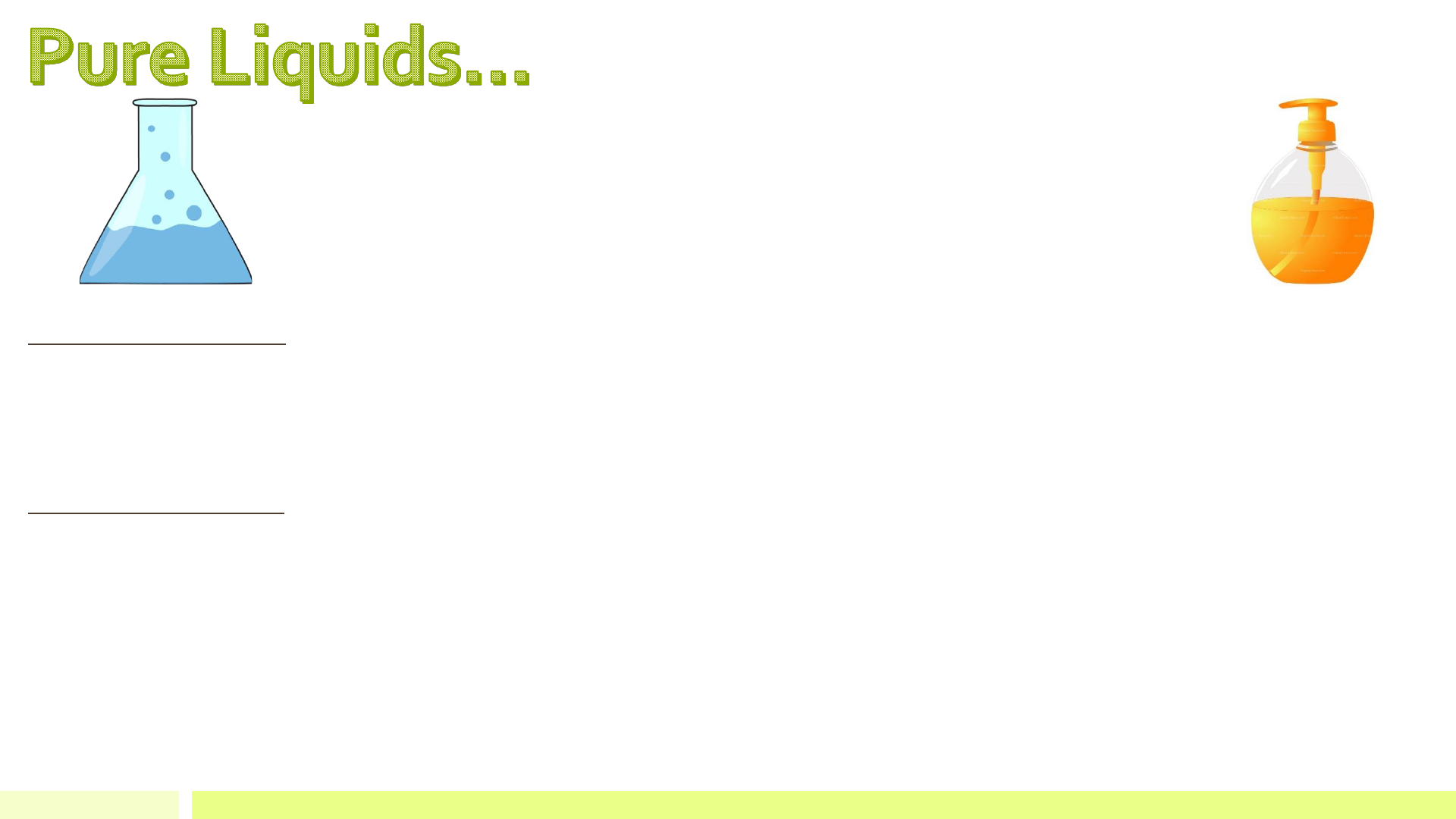
Conversion of Pure Liquids
Liquid = flowing freely like water
Having the properties of a liquid: being neither solid nor gaseous
Example 1 (pure liquids): You must convert gallons to pounds. Company B has a 5,000- gallon tank filled with methyl isobutyl ketone.
What is the weight of methyl isobutyl ketone?
Gallons of EHS x density (see Note#1) (pounds/gallon from SDS) = pounds of EHS
5,000 gallons EHS x 6.7 pounds/gallon – 33,500 pounds of methyl isobutyl ketone (Above Threshold)
Example 2 (pure liquids):
Example 2 (liquids): Company B has 28 car batteries sitting on their shelf. Car batteries contain lead, in a solid form, and Sulfuric Acid, in a
liquid form. What is the weight of Sulfuric Acid? Car batteries contain approximately 35% of Sulfuric Acid.
28 car batteries x 39 pounds = 1,092 pounds
1,092 pounds x .35 = 382 pounds of Sulfuric Acid (Below Threshold).
This example is an estimate and the calculations presented here may not be the actual calculations that you derive. Therefore, please
refer to your SDS for an exact figure to determine your reporting threshold.
(cont’d)
Pure Liquids…
9

Conversion of Mixtures
Mixture = a portion of matter consisting of two or more components
in varying proportions that retain their own properties.
Example 1 (liquids – mixtures): Company C has 10 gallons of paint containing 15% (0.15) toluene and 15 gallons of solvent
containing 20% (0.20) toluene. What is the weight of toluene?
Gallons of product x density of product (pounds/gallon from SDS) = pounds of paint
Pounds of paint x (% of EHS) = pounds of EHS
Paint :
10 gallons of paint x 8.3 pounds/gallon (see Note# 2) = 83 pounds of paint
83 pounds of paint x 0.15 (toluene) = 12 pounds of toluene in paint
Solvent:
15 gallons of solvent x 6.5 pounds/gallon (from SDS) = 98 pounds of solvent
98 pounds of solvent x 0.20 (toluene) = 20 pounds of toluene in solvent
To determine if the total quantity of toluene exceeds the reporting threshold, add the quantities of toluene:
12 pounds + 20 pounds = 32 pounds total toluene (Below Threshold)
(cont’d)
Mixtures & Liquids…
10

Notes:
1.) If the specific gravity of product is listed instead of density, you can get density by multiplying the
specific gravity by 8.3 pounds/gallon (density of water): Specific gravity x 8.3 pounds/gallon = density
of product (pounds/gallon)
2.) If the specific gravity and the density are not found on the SDS, use 8.3 pounds/gallon to estimate
weight.
• Example 2 (liquids – mixtures): Company D has 120 gallons of a mixture containing 40% (0.40)
benzene. The MSDS for the product indicates the specific gravity of the product is 0.96. How much
benzene is present in the mixture?
0.96 x 8.3 pounds /gallon = 8.0 pounds/gallon
120 gallons x 8.0 pounds/gallon = 960 pounds of product
960 pounds x 0.40 (benzene) = 384 pounds of benzene (Below Threshold)
(cont’d)
Cont’d Conversions…
11

Conversion of Gases
Gases = an airlike fluid substance which expands freely to fill
any space available, irrespective of its quantity.
• Example 1 (liquids – gases): You must convert cubic feet to pounds. Company H stores 2,000 cubic
feet of methane in liquid form and stores chlorine as a gas in five 1,000 cubic feet cylinders. What is
the maximum daily inventory of each EHS?
• Methane:
2,000 ft.
3
methane x 26.3 pounds/ft.
3
(table) = 52,600 pounds of methane (liquid) (Above
Threshold)
• Chlorine:
1,000 ft.
3
/cylinder x 5 cylinders = 5,000 ft.
3
of chlorine gas
5,000 ft.
3
x 0.200 pounds/ft.
3
(table) = 1,000 pounds of chlorine gas (Above Threshold)
Gases…
12

Gas Stored as Gas
lbs./ft.
3
Stored as Liquid
lbs./ft.
3
Acetylene
.068 24.0
Ammonia
.048 38.0
Chlorine
.200 87.7
Dichlorodifluoromethane
(Freon 12) .329 82.7
Chlorodifluoromethan
e (Freon 22) .461 75.5
Hydrogen
.005 4.28
Methane
.043 26.3
Nitrogen
.073 50.5
Oxygen
.083 71.2
Propane
.155 36.0
1,1,2
Trichloro- 1,1,2 trifluoroethane
(Freon 113)
.231 97.7
Figure 1: Gas Conversion Table
13
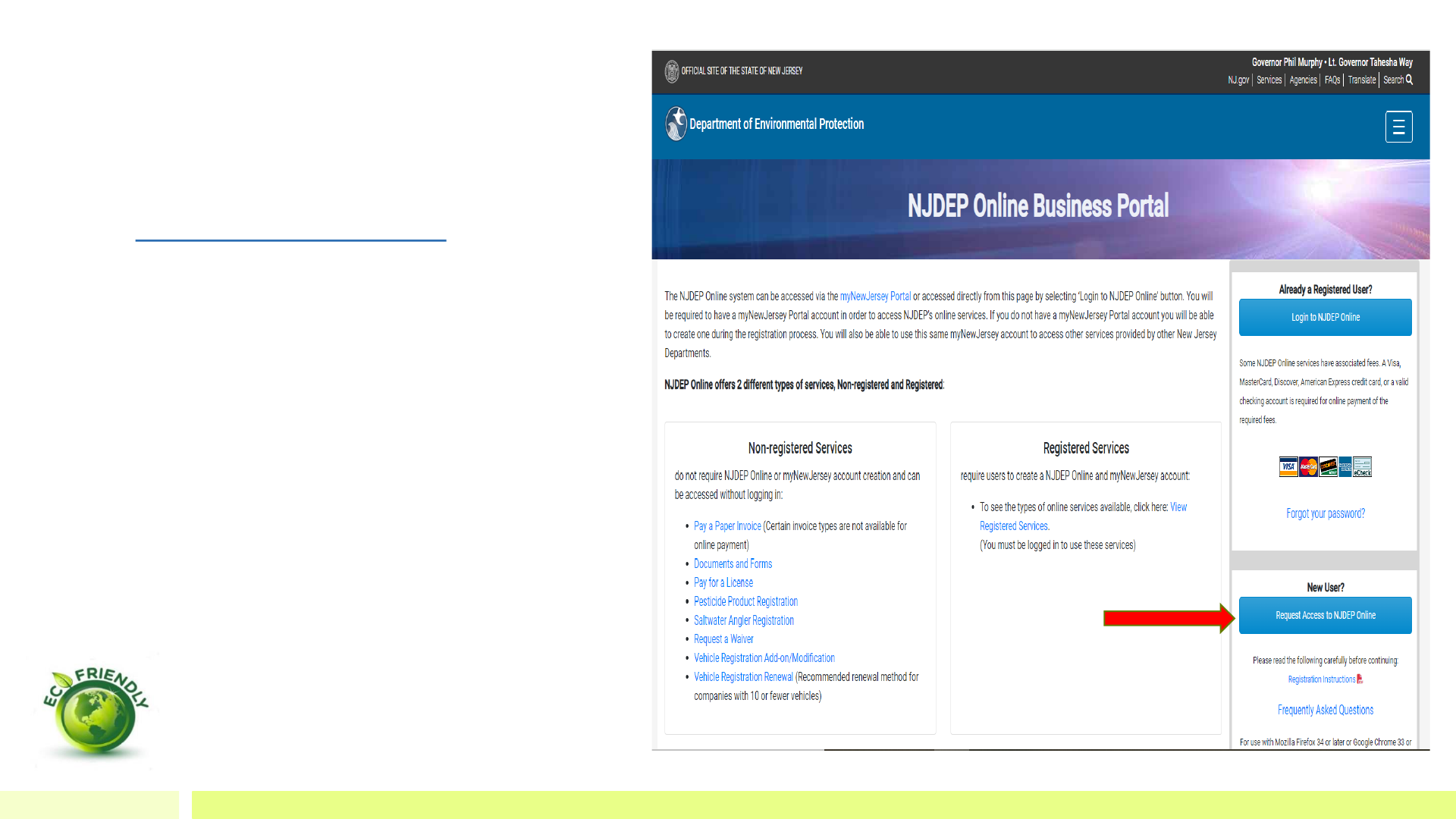
Steps to getting started…
New user account set-up requesting access:
• Go to www.njdeponline.com and click on
“Request Access to NJDEP Online.”
• Please note, if you already have an account
created you can simply log in.
For use with Microsoft Internet Explorer 11, Mozilla Fire Fox
34 or later and Google Chrome 33 or later.
For optimal performance, it is advised to maintain only one
browser window or tab when using NJDEP Online.
15

Creating your account and linking to NJDEP online…
• Fill in all required fields.
• Click on the “Request” button.
16

Linking your NJDEP online services…
• If you do have a MyNewJersey
Account:
Fill out section (A) with your
myNewJersey “Log On ID and
Password” and click on Link
NJDEP Online to My Account.
• If you do not have a MyNewJersey
Account:
Fill out section (B) with your
desired “Log On ID, Password,
Security Question and Security
Answer” and click on Create this
new myNewJersey Account and
Link NJDEP Online to It. (Please
remember to write down your information
and keep it for your records.)
17

The “MyNewJersey" portal was developed so that businesses and individuals had to login only once and then navigate to the appropriate program that they needed.
The State's goal was to eliminate the different login ID'S as well as trying to remember
each individual website that people had to go to in order to conduct business with the State of New Jersey.
http://www.nj.gov/
18

Adding your contact information…
• Please fill out the required fields where
you see the asterisk (*) symbol,
including the Contact Numbers section.
• Next, click on the “Add Contact
Number” to input your information.
19

Adding your contact number…
• Please note that your contact
number must be entered without
dashes. Ex.6092922082
• Once, you filled out the contact
number information you can hit
“Save.”
20
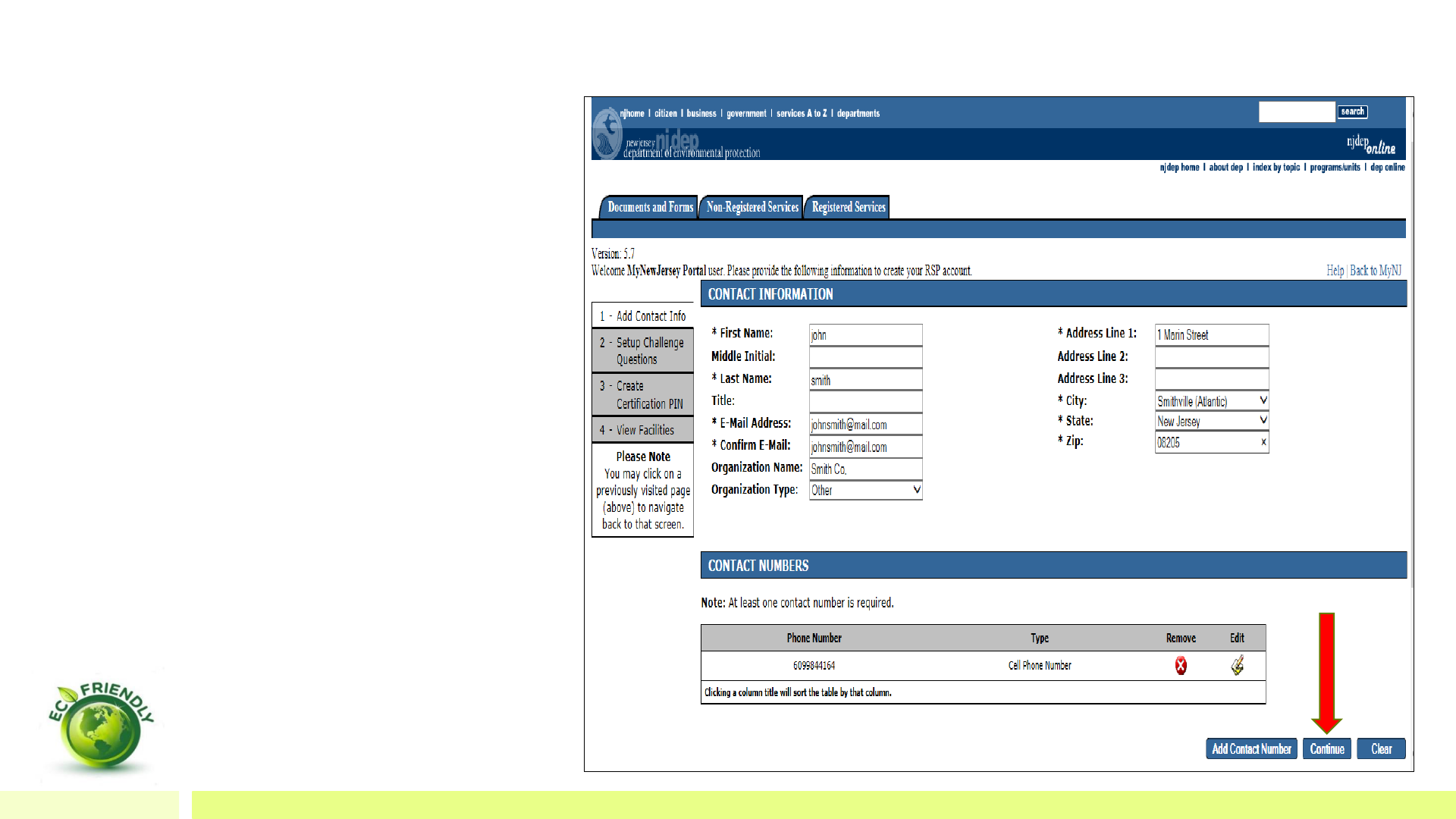
Finishing up your contact information…
• Complete all required fields and
double check to make sure all your
information is correct.
• After, you have filled out all your
information please hit “Continue.”
21

Next, let’s set-up your challenge questions…
• There are “five” challenge questions
for the purposes of protecting your
security. Please note that you cannot
have the same answer to more than
one question.
• Once you are finished, this will take
you to the next page, that will then
ask you to create a Certification
(PIN) Personal Identification
Number.
22

Creating your Certification (PIN)Personal Identification Number…
• Now, that you have successfully
completed the challenge
questions, you will be asked to
create a Certification PIN.
• The Certification PIN is used to
electronically certify a
permit/application/submittal.
However, it is not required to
submit the eCRTK Survey.
• Please keep your Certification
PIN in a safe place for you to
locate and remember.
23
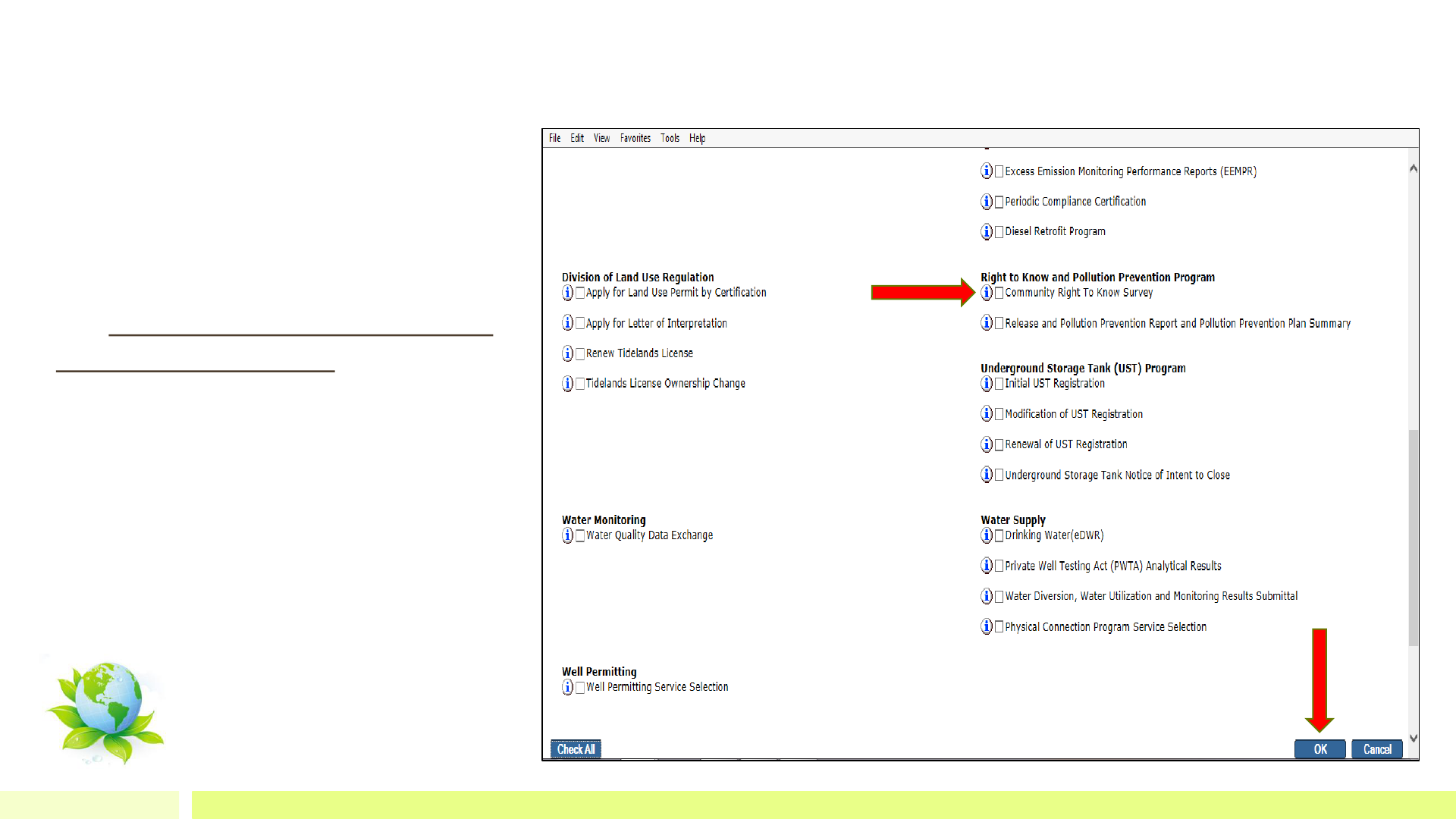
Adding the CRTK Program to your MyNewJersey account…
• On the right side of your screen,
there will be a list of NJDEP
programs. Scroll down to locate
the Right to Know and Pollution
Prevention Program and click
next to the Community Right to
Know Survey.
• Next, check the box next to it
and hit “Ok.”
24

You can now add your facility…
• After, the CRTK Program has
been added, you will be
prompted to add your
facility. Click on “Add
Facilities.”
25

Searching for your facility…
• Below the Facility Search,
under “Pick the search you
want to perform:” leave the
first radio button ()
marked.
• Input your 11 digit facility
identification number.
Remember to keep all the
zeroes and leave the facility
name blank.
• Hit search.
00000012345 X
26

Results after searching for your facility…
• You should now see your
facility. Make sure the box next
to your facility is marked and
hit “Add Selected Facilities.”
27

Completing the set-up of your facility…
• If you need to add more
facilities click “Add Facility.”
• If you have multiple
locations please use the
“Add Facility”, which it will
direct you back to the
Facility Search screen.
• You will see that your
facility is now added and
you can select “Complete
Setup.”
TEST FACILITY 55 00000012345 Right to Know Individual With Direct Knowledge Granted
28

Be sure to click “DONE”…
TEST FACILITY 55 00000012345 Right to Know Individual With Direct Knowledge Granted
• Once you have added your
facility/facilities, please
click on “DONE” to finish
the set-up process.
29

Congratulations! Your finished with the set-up process.
• And your page should
look like this.
30

You are now ready to start the eCRTK Survey.
***Security Alert!***
Before starting the eCRTK Survey make sure your web browser is updated or have an installed new version to support this application.
31

First, go to your My Workspace tab…
• Click on the My Workspace tab, in
the upper left hand side of
the screen.
• To access your eCRTK Survey click
on the corresponding link.
--
32
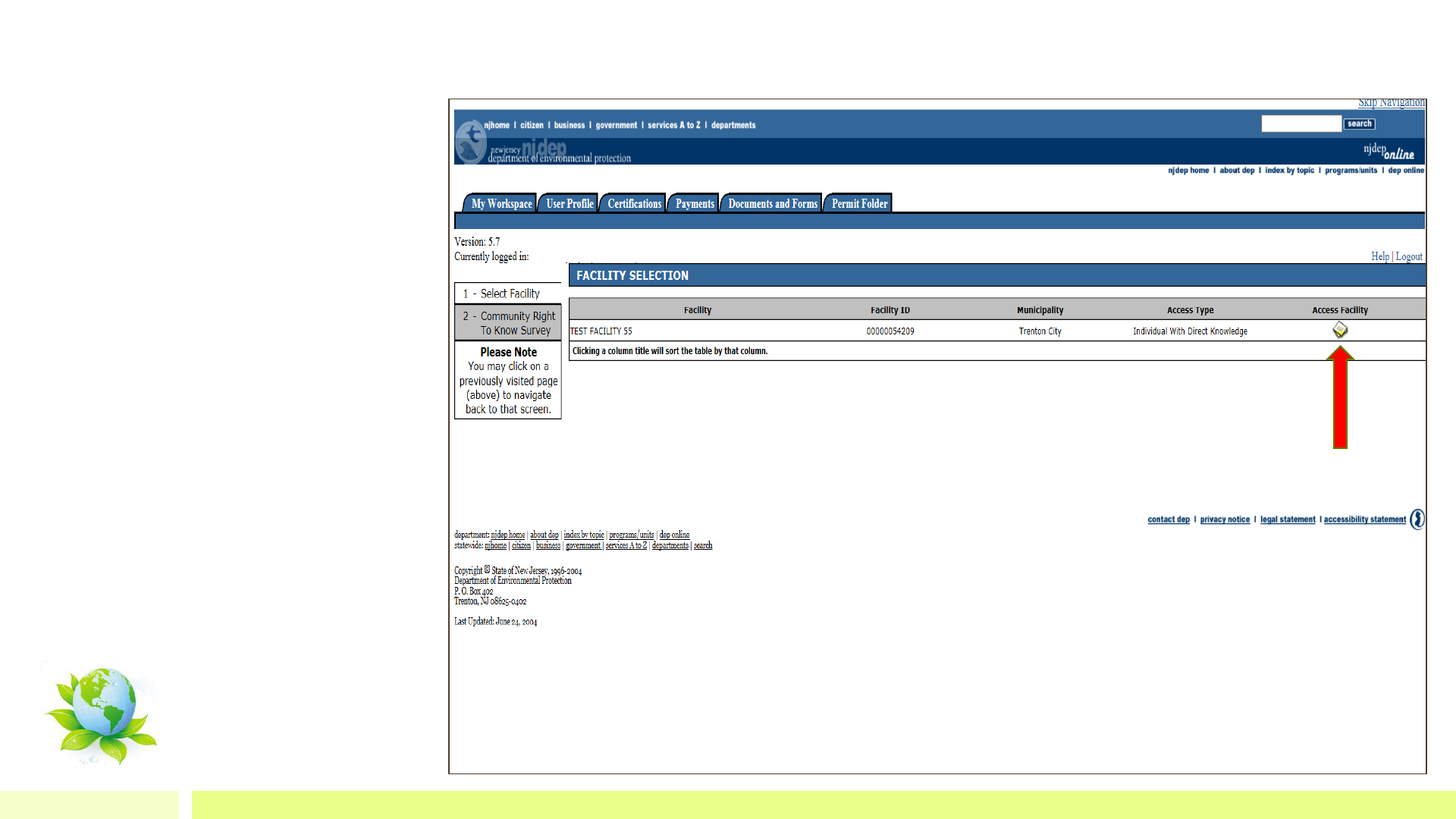
Next, let’s access your facility…
• After, clicking the eCRTK
Survey link you will see your
facility show up. Click on the
icon under “Access Facility”
to see your facility.
--
33

Accessing your eCRTK Survey…
• Make sure that you are in the
current reporting year before
starting the survey.
34

Five quick and easy steps in completing the eCRTK Survey…
35

Step 1: Company/Facility Information
• Please complete all that
applies to your
company/facility.
• You will need to check off on
section (B) if your
company/facility has
environmental hazardous
substances above or below
the reporting threshold.
• Once, you completed this
section of the eCRTK Survey
click “Save to File.”
Facility ID: 00000012345 Facility Name: TEST FACILITY 55
36

Step 2: Substance List
• If you have reported chemicals
from the previous year, it will be
reported into the current
reporting year’s survey.
• Deleting chemicals: Click on that
particular chemical and than click
the “Delete Substance” tab.
• If a red “X” is marked next to the
chemical please update it. Once it
is updated, it will have a
green“.”
• Adding new chemicals: This
information can be found on the
next slide.
• Once you completed this section
of the eCRTK Survey click “Save
to File.”
Facility ID: 00000012345 Facility Name: TEST FACILITY 55
37

Cont’d Step 2: Adding New Chemicals and Information
• You can click on the “Name” or
“CAS #” to find the chemical that
your company/facility used in that
corresponding year.
• Next, select the box(es) that
corresponds to your chemical(s)
and click the “Add Substance(s)”
tab located in the upper right hand
corner of your screen.
• Once, your chemical substance is
added please fill out all necessary
information associated with that
chemical.
Facility ID: 00000012345 Facility Name: TEST FACILITY 55
38

Step 3: Verifying Data
• Once, all contact information and
chemicals have been added click on
“Verify Data.”
• If by chance, your survey is missing
information you will see a message
that will prompt you to complete all
required fields.
Facility ID: 00000012345 Facility Name: TEST FACILITY 55
39

Now, that the corrections are fixed you are ready to submit.
Facility ID: 00000012345 Facility Name: TEST FACILITY 55
40
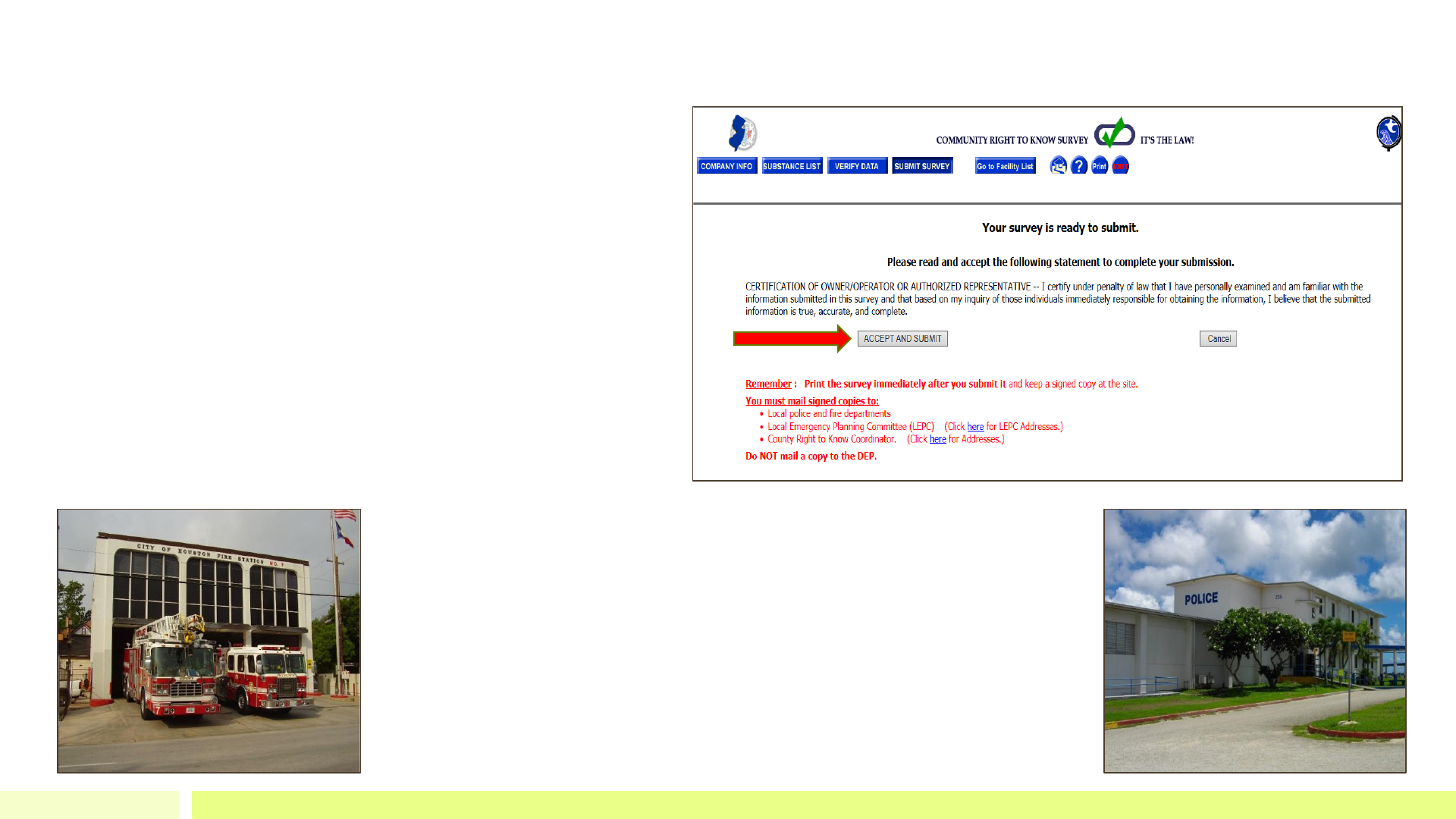
Step 4: Submitting your eCRTK Survey
• Once you hit “Submit” it will be
electronically sent to us.
• Make sure you save a copy for your
records.
• Now, that you have completed and
submitted the form please print, sign and
send a copy to your local:
1.) Police Department
2.) Fire Department
3.) County Right to Know Lead Agency
4.) Local Emergency Planning Committee
Facility ID: 00000012345 Facility Name: TEST FACILITY 55
41

Step 5: Click the Button
To Log out of eCRTK
EXIT
42



